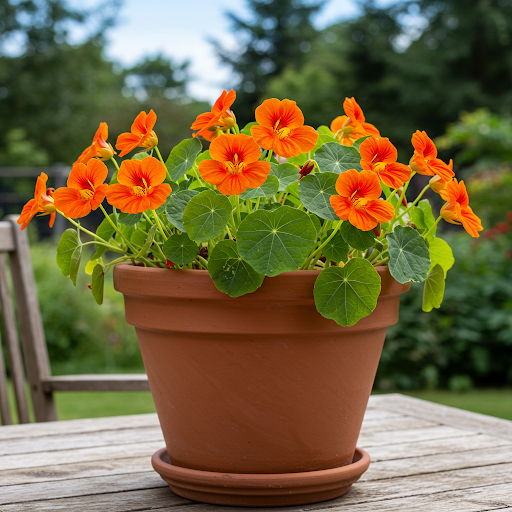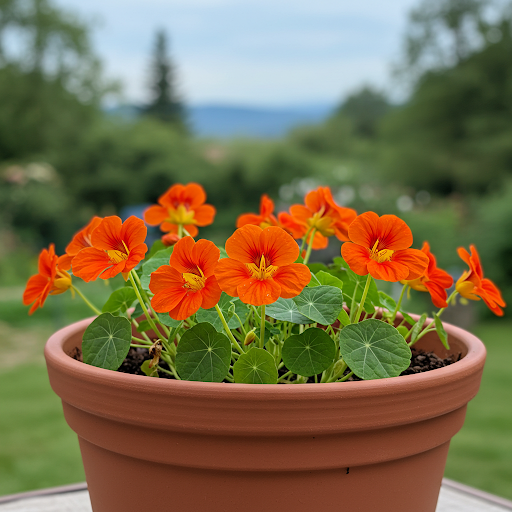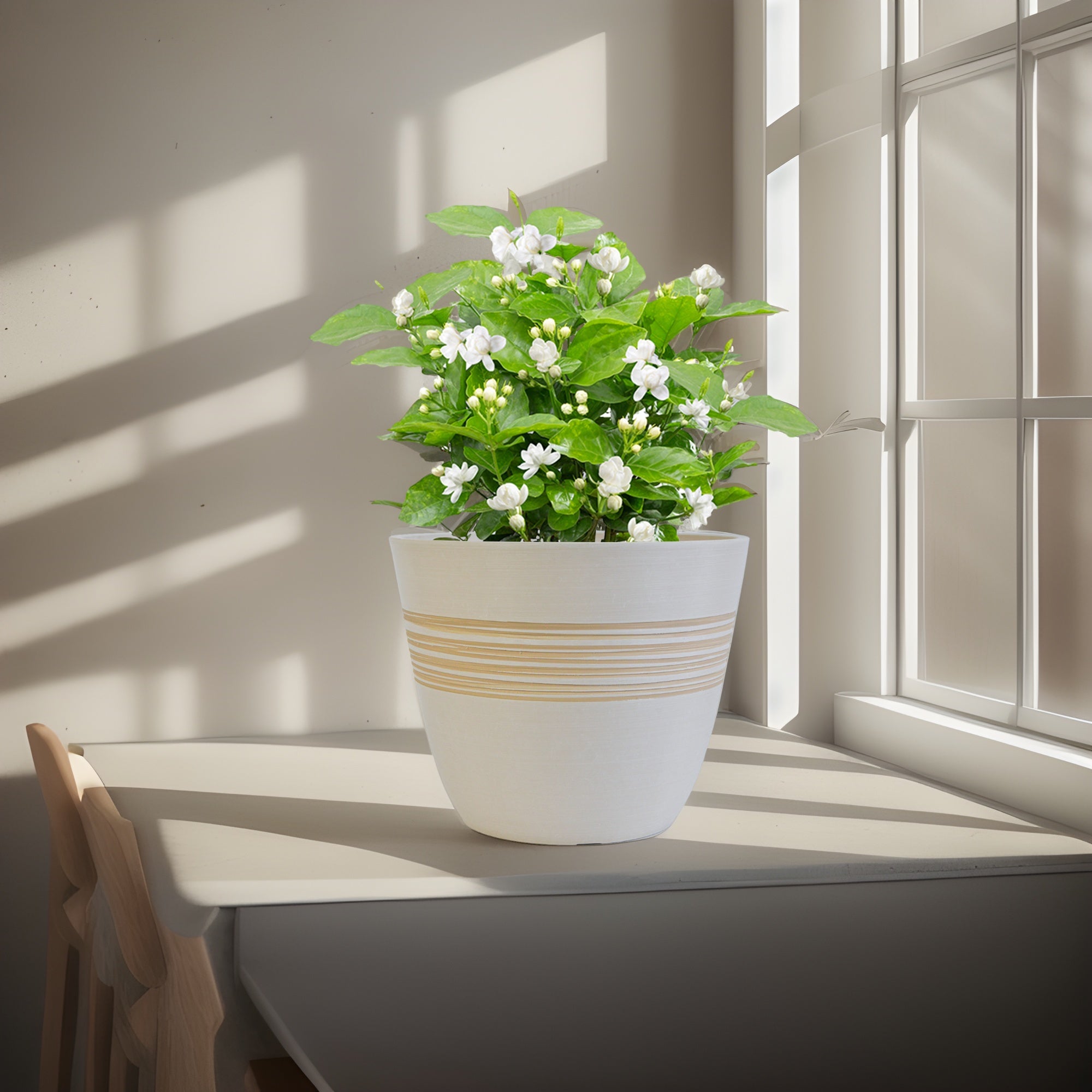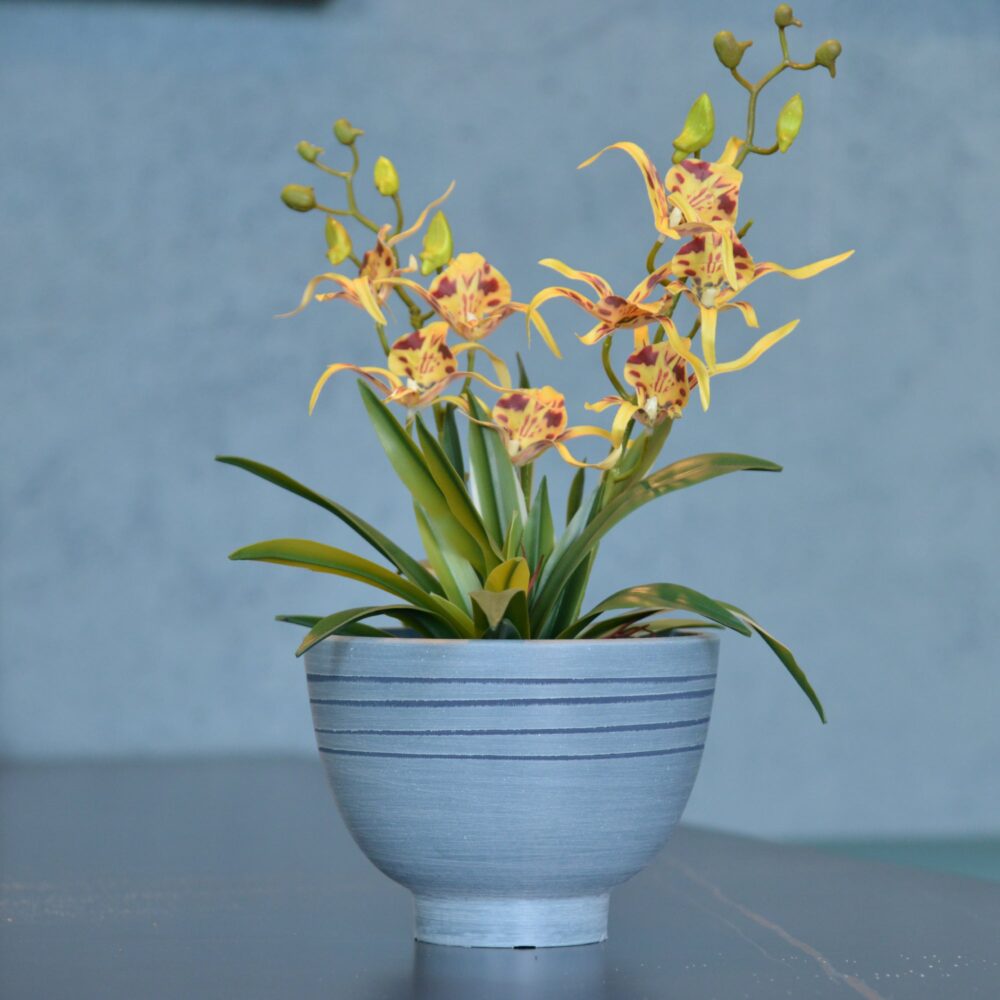Nasturtiums in Pots: The Complete Guide to Growing Nasturtiums in Containers Outdoors
Want to add a cascade of cheerful blooms and peppery edible leaves to your patio, balcony, or garden? Nasturtiums are a delightful and incredibly easy choice for outdoor container gardening. Prized for their vibrant, trumpet-shaped flowers, attractive round leaves, and edible nature, nasturtiums are perfect for adding beauty and utility to your outdoor living spaces. This comprehensive guide will provide you with everything you need to know to grow nasturtiums successfully in outdoor pots, from selecting the best varieties and containers to mastering essential care techniques for a season filled with nasturtium charm and flavor.

Nasturtiums
What are Nasturtiums (Tropaeolum)?
Nasturtiums (Tropaeolum) are a genus of flowering plants in the family Tropaeolaceae, native to the Andes in South America. Often grown as annuals, nasturtiums are beloved by gardeners for their bright, trumpet-shaped flowers, unique, round, umbrella-like leaves, and peppery flavor that permeates the entire plant – flowers, leaves, and seed pods are all edible. Nasturtium flowers come in warm, vibrant colors, including shades of yellow, orange, red, and mahogany, and attract pollinators like bees and hummingbirds. They are broadly categorized into types based on growth habit, including Bush Nasturtiums and Trailing Nasturtiums. Nasturtiums are cherished for their easy-to-grow nature, long blooming season, edible flowers and leaves, pest-repellent qualities, and ability to thrive in less-than-perfect soil, making them a versatile and rewarding addition to any container garden, herb garden, or vegetable garden.
Are Nasturtiums (Tropaeolum) Good for Outdoor Pots?
Yes, Nasturtiums (Tropaeolum) are exceptionally well-suited for outdoor pots and container gardening. Their bushy, compact, and trailing growth habits make them ideal for filling pots, window boxes, hanging baskets, and raised planters with vibrant color and cascading foliage. Nasturtiums are vigorous growers and bloom profusely throughout the summer and into fall, providing a long-lasting and cheerful display in containers. Their adaptability, edible nature, and ease of care make them a fantastic and practical choice for container gardens of all styles, especially for adding beauty and functionality to patios, balconies, and decks.
Ideal Growing Conditions for Nasturtiums (Tropaeolum) in Pots:
- Types of Nasturtiums for Pots: Both bush and trailing nasturtiums are excellent for pots, but consider your desired look and container type when choosing:
- Bush Nasturtiums: (e.g., ‘Alaska’, ‘Empress of India’, ‘Jewel Mix’) – Compact and mounding, typically reaching 1-2 feet tall and wide, ideal for standard pots, window boxes, and mixed containers. Known for their neat, bushy habit, often variegated foliage, and upright flower display. Excellent for adding structure and color to container arrangements.
- Trailing Nasturtiums: (e.g., ‘Trailing Mix’, ‘Canary Creeper’, ‘Peach Melba’) – Vining and cascading, can trail 2-6 feet or more, perfect for hanging baskets, tall planters, and allowing to spill over pot edges. Known for their vigorous, trailing growth, cascading habit, and abundant flowers along the vines. Ideal for creating waterfalls of color and softening container edges.
- Dwarf Bush Nasturtiums: (e.g., ‘Tom Thumb Mix’, ‘Whirlybird Mix’) – Extra compact and small, typically under 1 foot tall and wide, best for smaller pots, tight spaces, and edging containers. Very manageable size for limited spaces.
- Light: Nasturtiums thrive in full sun to partial shade. They bloom best and produce the most vibrant colors in full sun (at least 6-8 hours of direct sunlight per day). In very hot summer climates, partial shade during the hottest part of the afternoon can be beneficial to prevent leaf scorch and prolong bloom time, especially for darker colored varieties. In shadier locations, nasturtiums will still grow and flower, but blooms may be less abundant and colors less intense. Choose a location for your nasturtium containers that provides as much sun as possible, or partial shade in very hot regions.
- Soil: Nasturtiums are famously not fussy about soil and actually prefer slightly poor to moderately fertile, well-draining soil. Rich soil can encourage excessive foliage growth at the expense of flowers. Use a standard, well-draining potting mix for containers. Amending potting mix with a bit of compost is acceptable, but avoid overly rich or heavily fertilized soils. Good drainage is more important than rich soil for nasturtiums in pots. They tolerate a wide pH range, but slightly acidic to neutral (pH 6.0-7.0) is ideal.
- Watering: Nasturtiums are relatively drought-tolerant once established, but they perform best with consistent moisture, especially when grown in pots. Water thoroughly when the top inch of soil feels dry. Water deeply until water drains out of the drainage holes. Allow the soil to slightly dry out between waterings. Avoid overwatering and soggy soil, which can lead to root rot. Nasturtiums are more tolerant of slightly dry conditions than consistently wet soil. Water less frequently in cooler weather or shade. Check soil moisture regularly and adjust watering frequency based on weather conditions and pot size. Water at the base of the plant to keep foliage and flowers dry and help prevent fungal diseases.
- Temperature: Nasturtiums are cool-season annuals that thrive in moderate temperatures. They perform best in temperatures between 60°F to 75°F (15°C to 24°C). They are tolerant of light frost but are damaged by hard freezes. Plant nasturtium seeds or seedlings outdoors after the last frost in your area, or start seeds indoors a few weeks before the last frost for earlier blooms. They can tolerate warmer summer temperatures, especially with afternoon shade and consistent moisture, but bloom best in cooler periods of the growing season. In very hot summer climates, flowering may slow down during the peak heat, but will often resume when temperatures cool down in late summer and fall.
- Fertilizer: Nasturtiums are light feeders and generally do not require fertilization, especially if grown in moderately fertile potting mix. Avoid fertilizing nasturtiums, as it can encourage excessive leafy growth and reduce flowering. If soil is very poor, you can apply a very dilute, balanced liquid fertilizer (e.g., 10-10-10) once or twice during the growing season, but it is usually not necessary and can be detrimental to bloom production. Nasturtiums thrive on neglect and bloom best when not over-pampered with rich soil or fertilizers.
Choosing the Right Pots for Nasturtiums (Tropaeolum):
- Suitable Pot Types: Nasturtiums are adaptable to various pot types, including terracotta, ceramic, plastic, resin, hanging baskets, and window boxes. Consider these factors when selecting pot types for nasturtiums:
- Terracotta Pots: Porous, allow good aeration and drainage, and aesthetically classic, and dry out more quickly, which is often suitable for nasturtiums preference for slightly drier conditions. Well-suited for bush nasturtiums and in hotter climates.
- Ceramic Pots: Available in many decorative styles, retain moisture better than terracotta, and can add a decorative element to your container garden. Ensure good drainage. Good for trailing nasturtiums and in slightly cooler or drier climates.
- Plastic Pots: Lightweight, inexpensive, retain moisture well, available in various colors and styles. Choose good quality plastic pots that are durable and UV-resistant. Good for all nasturtium types, especially for hanging baskets and larger plantings.
- Resin Pots: Lightweight, durable, available in various styles mimicking terracotta or ceramic, and retain moisture well. A good alternative to heavy ceramic pots, and often offer better moisture retention than terracotta.
- Hanging Baskets: Ideal for trailing nasturtiums, create cascading displays of blooms and foliage. Choose baskets with good water retention and sturdy hangers. Line baskets with coco coir or sphagnum moss to help retain moisture.
- Window Boxes & Long Planters: Excellent for mass plantings of bush nasturtiums or mixed arrangements of bush and trailing types on windowsills, railings, or as porch planters. Trailing types will spill beautifully over the edges. Choose boxes with good drainage and sufficient depth.
- Drainage: Good drainage is important for nasturtiums to prevent root rot, although they are relatively drought-tolerant. Ensure your chosen pot has drainage holes at the bottom. Avoid pots without drainage holes. Elevating pots slightly can improve drainage and air circulation around the base. Adding a layer of gravel or pot shards at the base of the pot is generally not necessary if using a well-draining potting mix, but can be done for extra precaution, especially in very heavy pots or mixes.
- Pot Size: Choose pot sizes appropriate for the type and mature size of the nasturtium you are planting.
- Bush Nasturtiums: For bush nasturtiums, pots that are 6-8 inches in diameter are suitable for individual plants. For fuller displays or multiple plants, use pots that are 10-12 inches or larger, or window boxes.
- Trailing Nasturtiums: Trailing nasturtiums need larger containers to accommodate their vining growth. Hanging baskets and pots should be at least 10-12 inches in diameter, and can be larger for more mature displays and to allow for more extensive trailing.
- Dwarf Bush Nasturtiums: For dwarf bush nasturtiums, smaller pots that are 4-6 inches in diameter can be used for individual plants. For mass plantings, use larger pots or window boxes, spacing plants closely.
- Depth: Ensure pots are at least 6-8 inches deep for all nasturtium types to provide adequate root space. Deeper pots are better for trailing varieties to allow for more root development.
- Color and Style: Choose pot colors and styles that complement your nasturtium blooms and your outdoor décor. Terracotta pots enhance the natural, cottage-garden look of nasturtiums, while brightly colored pots can create a more vibrant and playful display. Consider using contrasting pot colors to make nasturtium blooms pop, or choose earthy tones to blend with foliage.
Essential Care Tips for Thriving Nasturtiums (Tropaeolum) in Outdoor Pots:
- Watering: “Water When Topsoil is Dry, Avoid Overwatering”. Water thoroughly when the top inch of soil feels dry. Allow the soil to slightly dry out between waterings. Avoid overwatering and soggy soil. Water less frequently in cool or cloudy weather.
- Sunlight: Provide Full Sun to Partial Shade. Place nasturtium pots in a location that receives full sun for best blooming, or partial shade in very hot climates.
- Fertilizing: Avoid Fertilizing. Nasturtiums generally do not need fertilizer and can bloom less if over-fertilized. Avoid fertilizing unless soil is extremely poor, and then use a very dilute, balanced fertilizer sparingly.
- Deadheading (Encourage More Blooms – Optional): Deadheading spent flowers is not strictly necessary for nasturtiums to continue blooming, but removing faded flowers and developing seed pods can encourage more abundant and prolonged flowering, and keep plants looking tidier. Pinch or snip off spent flower heads. If you want to collect seeds, allow some flowers to mature into seed pods.
- Pinching Back (Promote Bushiness – Optional): Pinch back leggy stems or overgrown nasturtiums to encourage branching and bushier growth, especially for bush types. Pinching back stem tips can create fuller plants. You can also trim back trailing stems if they become excessively long or unruly.
- Pest and Disease Control: Nasturtiums are generally relatively pest and disease-resistant, and are even known to repel certain pests in the garden. However, monitor for common pests like aphids, flea beetles, and spider mites. Viral diseases can occasionally occur. Nasturtiums are generally less prone to fungal diseases, especially if good air circulation and well-draining soil are provided. Treat any pest or disease issues promptly with insecticidal soap, horticultural oil, neem oil, or appropriate insecticides or fungicides if necessary.
- Edible Flowers, Leaves, and Seeds: Nasturtium flowers, leaves, and immature seed pods are all edible and have a peppery, slightly spicy flavor. Use flowers and leaves fresh in salads, as garnishes, or in other culinary applications. Immature green seed pods can be pickled and used as a substitute for capers. Harvest flowers and leaves as needed throughout the growing season.
Popular Nasturtium Cultivars for Pots (by Type):
- Bush Nasturtiums: ‘Alaska’, ‘Empress of India’, ‘Jewel Mix’, ‘Double Delight’, ‘Tip Top Alaska Mix’
- Trailing Nasturtiums: ‘Trailing Mix’, ‘Canary Creeper’, ‘Peach Melba’, ‘Moonlight’, ‘Black Velvet’ (trailing types available in many colors)
- Dwarf Bush Nasturtiums: ‘Tom Thumb Mix’, ‘Whirlybird Mix’, ‘Baby Rose’, ‘Harlequin Mix’
In Summary:
Growing Nasturtiums (Tropaeolum) in outdoor pots is a wonderfully simple and rewarding way to add cheerful color, edible leaves and flowers, and even pest-repelling benefits to your patios, balconies, and gardens. Their easy-care nature, long blooming season, and adaptability to containers make them a perfect choice for gardeners of all levels. By providing full sun to partial shade, well-draining potting mix in pots with drainage, watering appropriately and allowing the soil to slightly dry between waterings, and avoiding fertilization, you can easily cultivate beautiful and useful nasturtium displays in pots and enjoy their charm and flavor all season long.

Nasturtiums
For more detailed botanical information and to explore the diverse world of Tropaeolum varieties, you can visit the Wikipedia page on Tropaeolum.
Important Note: Nasturtiums (Tropaeolum) are considered non-toxic to humans and pets, making them a safe and enjoyable choice for households with children and animals. The primary care benefit of nasturtiums in pots is their low-maintenance nature and adaptability. With these simple care practices, you can enjoy a season filled with the cheerful color, edible delights, and garden benefits of nasturtiums in your outdoor containers.
Flower pot recommendation
Planter for Indoor Outdoor Plants, Set of 2 Modern Decorative Plant Pots with Drainage Hole, Decorative Flower Pots
By greenship-seo|2025-04-10T07:46:01+00:00January 9, 2025|Categories: Hand-carving Series|Tags: Decorative Flower Pots, Self-Watering Pots|
HS
By greenship|2024-08-13T06:45:17+00:00August 13, 2024|Categories: Hand-carving Series|
8 inch/10 inch Planter Indoor Plants, 2 Pack Modern Decorative Plant Pots with Drainage Hole, Cute Bowl Shape Flower Pots
By greenship-seo|2025-04-10T08:03:42+00:00January 9, 2025|Categories: Hand-carving Series|Tags: Decorative Flower Pots, Self-Watering Pots|
KC3-14A
By greenship|2024-08-16T06:26:30+00:00August 16, 2024|Categories: Hand-carving Series|
Modern Plant Pots with Drainage – Indoor & Outdoor Use (6″ Widths)
By greenship-seo|2025-04-10T06:29:43+00:00February 6, 2025|Categories: Hand-carving Series|Tags: Decorative Flower Pots|
k2-21G
By greenship|2024-08-13T06:17:26+00:00August 13, 2024|Categories: Hand-carving Series|






